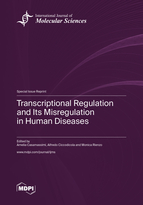Transcriptional Regulation and Its Misregulation in Human Diseases
A special issue of International Journal of Molecular Sciences (ISSN 1422-0067). This special issue belongs to the section "Molecular Genetics and Genomics".
Deadline for manuscript submissions: closed (30 June 2022) | Viewed by 53819
Special Issue Editors
Interests: cancer; PRDM genes; transcriptional regulation
Special Issues, Collections and Topics in MDPI journals
2. Department of Science and Technology, University of Naples “Parthenope", Centro Direzionale, Isola C4-800143, Naples, Italy
Interests: human genetic diseases; molecular mechanism pathogenesis; whole-transcriptome analysis; non-coding RNAs
Special Issues, Collections and Topics in MDPI journals
Interests: PRDM genes; cancer; transcriptional regulation
Special Issues, Collections and Topics in MDPI journals
Special Issue Information
Dear Colleagues,
Transcriptional regulation is a critical biological process that allows the cell or an organism to respond to a variety of intra- and extracellular signals, to define cell identity during development, to maintain it throughout its lifetime, and to coordinate cellular activity. This control involves multiple temporal and functional steps as well as innumerable molecules including transcription factors, cofactors and chromatin regulators. It is well known that many human disorders are characterized by global transcriptional dysregulation because most of the signaling pathways ultimately target transcription machinery. Indeed, many syndromes and genetic and complex diseases—cancer, autoimmunity, neurological and developmental disorders, metabolic and cardiovascular diseases—can be caused by mutations/alterations in regulatory sequences, transcription factors, splicing regulators, cofactors, chromatin regulators, ncRNAs, and other components of transcription apparatus. It is worth noting that advances in our understanding of molecules and mechanisms involved in the transcriptional circuitry and apparatus lead to new insights into the pathogenetic mechanisms of various human diseases and disorders. Thus, this Special Issue is focused on molecular genetics and genomics studies exploring the effects of transcriptional misregulation on human diseases.
Dr. Amelia Casamassimi
Prof. Dr. Alfredo Ciccodicola
Dr. Monica Rienzo
Guest Editors
Manuscript Submission Information
Manuscripts should be submitted online at www.mdpi.com by registering and logging in to this website. Once you are registered, click here to go to the submission form. Manuscripts can be submitted until the deadline. All submissions that pass pre-check are peer-reviewed. Accepted papers will be published continuously in the journal (as soon as accepted) and will be listed together on the special issue website. Research articles, review articles as well as short communications are invited. For planned papers, a title and short abstract (about 100 words) can be sent to the Editorial Office for announcement on this website.
Submitted manuscripts should not have been published previously, nor be under consideration for publication elsewhere (except conference proceedings papers). All manuscripts are thoroughly refereed through a single-blind peer-review process. A guide for authors and other relevant information for submission of manuscripts is available on the Instructions for Authors page. International Journal of Molecular Sciences is an international peer-reviewed open access semimonthly journal published by MDPI.
Please visit the Instructions for Authors page before submitting a manuscript. There is an Article Processing Charge (APC) for publication in this open access journal. For details about the APC please see here. Submitted papers should be well formatted and use good English. Authors may use MDPI's English editing service prior to publication or during author revisions.
Keywords
- Transcription machinery
- Transcription factors
- Transcription cofactors and complexes
- Chromatin regulators
- Splicing regulators
- Noncoding RNAs
- Posttranscriptional modifications
- Transcription misregulation
- Genetic alterations
- Human diseases









